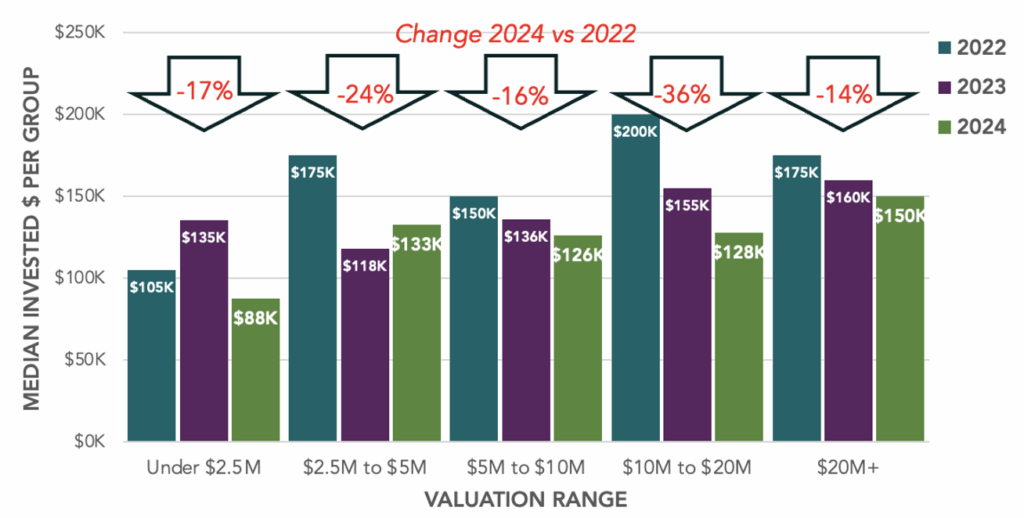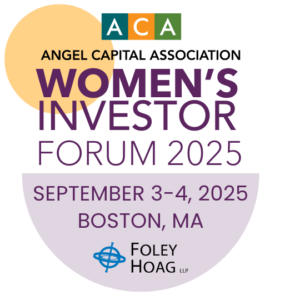Since 2022, valuations of later stage companies have declined dramatically, as have valuation multiples on exits (which are also much fewer in number). Normally, one would expect that early-stage valuations would also correct downwards in order for early-stage investors to be enthusiast about potential returns and hence opening up their checkbooks. But in 2024 the exact opposite occurred — valuations of Pre-Seed and Seed stage companies surged.
FIGURE 1. VALUATIONS FOR EARLIEST STAGES INCREASING

Source: 2025 ACA Angel Funders Report
Pre-Seed rounds, steady at roughly $4-$5M since 2021, doubled to $10M in 2024, and Seed climbed from the long-standing $7-$8M range to the same $10M mark in 2024. Series A remained remarkably consistent hovering at $15M for a fourth straight year. In contrast, growth-stage multiples have declined sharply: Series B slid from $32M at the 2021 peak to $19M in 2024, and Series C+ dropped from a high of $75M in 2022 to $35M in 2024.
The pattern suggests abundant competition for first institutional capital but also greater scrutiny, and limited VC appetite, later in the funding rounds, reinforcing the need for founders to convert early momentum into tangible revenue traction before pursuing larger follow-ons.
As micro-VCs (and even some of the larger VCs) are investing more in the earlier stages, they also seem to be contributing to this lack of discipline in demanding lower valuations for Seed and Pre-Seed. Another factor may be new angel members who lack a historical perspective on how valuations need to contract when exit multiples and later stage valuations contract. Given the flat valuations of Series A despite the rise in early stage valuations, this is causing fewer up-rounds at the Series A stage – this leads to compression that will depress long-term returns for early-stage investors since those early increases in valuation in Series A are critical to offset the dilution when more significant capital is injected at Series A.
The result is that early-stage investors as a class are keeping their powder dry – thus depressing investment amounts in this asset class. Total investment fell 6% in 2024 after dropping 33% in 2023.
FIGURE 2. ACA ANGEL INVESTMENT DECLINED 6% YOY

Source: 2025 ACA Angel Funders Report
This valuation crunch is depressing funding per deal across all valuations. FIGURE 3 plots median angel group check size against the pre-money valuation of the round and shows that investors continued to tighten purse-strings in 2024:
FIGURE 3. FUNDING PER DEAL DECLINED ACROSS ALL VALUATIONS

Source: 2025 ACA Angel Funders Report
At the very earliest tiers (< $2.5M valuations), angel groups invested a median $88K per deal, down 17% since 2022, while the $2.5–$5M range decreased 24% in 2024 compared to the 2022 peak. The pullback is similar for investment amounts in the $5–$10M valuation range down 16% in 2024 versus 2022. The pullback relative to 2022 is largest for rounds with a valuation between $10–$20M which dropped by 36%. Deals priced above $20M slipped the least since 2022 at 14%.
The uniform downshift suggests angels are reserving larger commitments for only the most attractively priced opportunities, preferring to seed more companies at the low end rather than chase higher valuations. In effect, funding discipline has cascaded across the cap table, reinforcing a valuation-sensitive environment in which founders must justify premium pricing with generally more traction to secure more significant investment amounts.
This valuation increase is not driven by a few hot sectors – the median valuations are increasing across most sectors. Sectors on the upswing in 2024 vs 2023 included PropTech (+150%), Pharma/Therapeutics (+47%), Consumer Products & Services (+45%), Digital Health (+33%), Industrials / BTB (+29%), Medical Devices (+22%), Medical Diagnostics (+20%), Financial / Fintech (+11%) and Materials / Chemicals (+10%). Only three sectors declined: IT Hardware (-32%), Agriculture/Food (-11%) and Energy & CleanTech (-11%). SAAS/Software and Consumer Internet saw no change in median valuation
FIGURE 4: VALUATIONS FOR MOST SECTORS INCREASED

Source: 2025 ACA Angel Funders Report
KEY TAKEAWAYS
- Early-Stage Valuations are increasing at a time of dropping later stage valuations, causing compression with implications:
- More dilution to early investors at time of follow-on rounds
- More risk of future down-rounds, leading to loss of momentum and potentially fatal consequences
- Potentially lower future returns
- More discipline is needed to control early-stage valuations and maintain a healthy discount to exit valuations
AUTHOR: John Harbison, Chair Emeritus of TCA Venture Group and ACA Data Analytics Committee Chair







